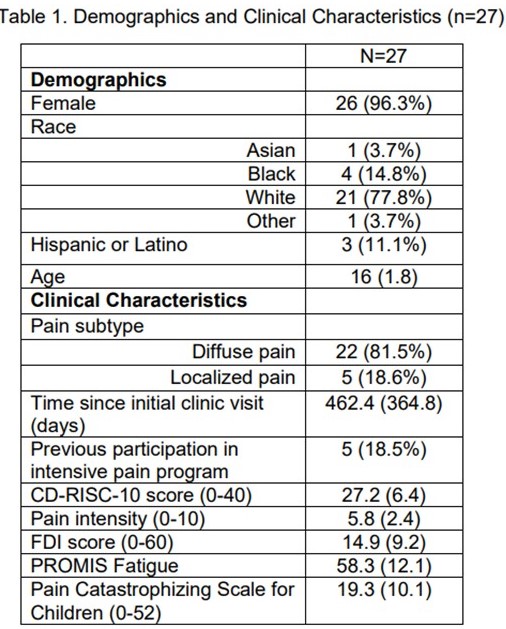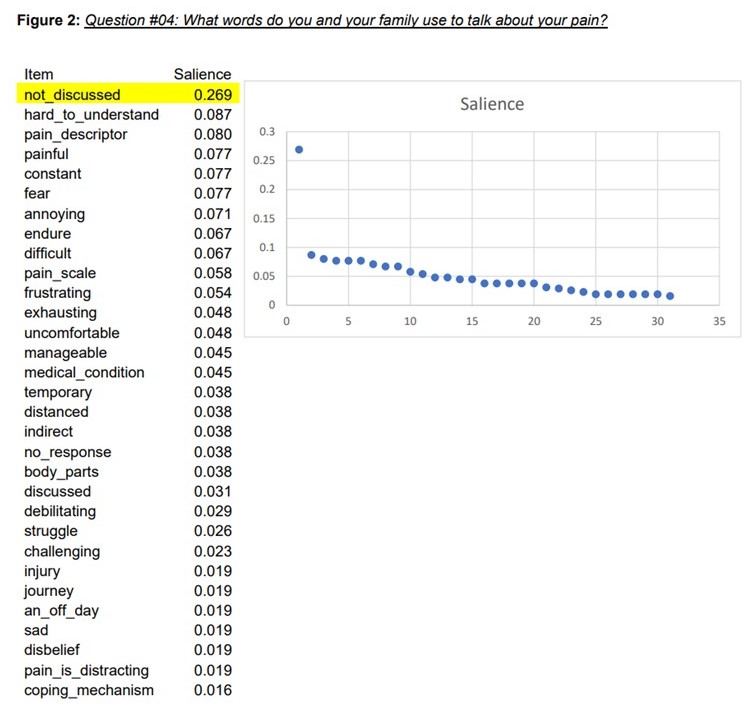Back
Abstract Session
Session: Abstracts: Patient Outcomes, Preferences, and Attitudes: Patient Priorities and Preferences: Interventions and Transformation (2243–2247)
2244: Salient Coping Strategies Among Youth with Chronic Musculoskeletal Pain
Monday, November 14, 2022
4:45 PM – 4:55 PM Eastern Time
Location: Room 114 Nutter Theatre
.png)
Sabrina Gmuca, MD, MSc
Children's Hospital of Philadelphia
Media, PA, United States
Presenting Author(s)
Sabrina Gmuca1, Daneka Stryker2, Mackenzie McGill1, Whitney Eriksen3 and Peter F. Cronholm4, 1Children's Hospital of Philadelphia, Philadelphia, PA, 2Drexel University College of Medicine, Philadelphia, PA, 3Jefferson Health, Philadelphia, PA, 4University of Pennsylvania, Philadelphia, PA
Background/Purpose: Youth with chronic musculoskeletal pain (CMP) learn pain-coping strategies and build resilience through cognitive behavioral therapy (CBT). In order to expand therapeutic options for youth with CMP, we need to improve our understanding of coping strategies they find most helpful or utilize most often. Thus, we aimed to identify salient coping strategies among youth with CMP established in a pediatric rheumatology pain clinic, through the freelisting method. The objective was to determine key knowledge, attitudes and practices regarding pain-coping to help inform the adaptation of resilience coaching programs for this patient population.
Methods: This was a qualitative study, complemented by retrospective chart review, of English-speaking youth with CMP, aged 12-18 years, presenting for a follow-up visit in a pediatric rheumatology subspecialty pain clinic between December 2020 and September 2021. All enrolled subjects participated in an interview session including: freelisting, probing questions, completion of the Connor-Davidson Resilience Scale 10-item (CD-RISC-10), and items to elicit study feedback. The freelisting questionnaire component, developed with the input of mixed-methods research specialists, elicited brief (1-2 word) responses to 12 questions about what activities, words, and sources of support youth find helpful for their pain. Audio recordings of the interviews were transcribed and Anthropac cultural domain analysis software was used to create salience scores (a composite measure accounting for item frequency and order) among responses to each freelisting question.
Results: Twenty-seven subjects completed the interviews (Table 1). Mean resilience level was 27.2 (+/-6.4). Individual-level coping strategies included “rest,” “distraction,” and “relaxation” (including “music”). Others reported “endure” as their response. Resources in school settings included “focus” and “leaves” as pain-coping strategies.
Professional networks included doctors, physical therapists, and psychologists. Personal networks included parents, teachers, siblings, and guidance counselors. Helpful group activities included: “performance arts,” “sports,” “exercise,” “visual arts,” and “clubs” (Figure 1). “Not Discussed” was the single salient term identified for how participants communicate their pain to family (Figure 2). While varied, additional explanations included avoiding thinking about their pain to not exacerbate symptoms, preferring to cope with pain alone, or feeling that the situation can’t be resolved by talking about it.
Most respondents enjoyed participating in the freelisting exercise. Comments included that the freelisting exercise was interesting to complete and a good way to generate answers.
Conclusion: The most salient coping strategies amongst youth with CMP included creative arts, exercise, and group activities, whereas participants commonly identified little communication with family members about pain. Future development of resilience coaching programs for this patient population should consider incorporation of creative arts, social interaction, and developing effective communication skills.
 Legend. PROMIS= Patient reported outcome measurement system. PROMIS scores are reported a T-scores, with a mean of 50 and standard deviation of 10 in a reference population; higher scores reflect higher levels of the associated domain. The pain catastrophizing scale for children (PCS-C) scores range from 0-52 with higher scores reflecting higher levels of catastrophic thinking. CD-RISC-10= Connor Davidson Resilience Scale 10 item. Scores range from 0-40 with higher scores indicating greater self-perceived resilience.
Legend. PROMIS= Patient reported outcome measurement system. PROMIS scores are reported a T-scores, with a mean of 50 and standard deviation of 10 in a reference population; higher scores reflect higher levels of the associated domain. The pain catastrophizing scale for children (PCS-C) scores range from 0-52 with higher scores reflecting higher levels of catastrophic thinking. CD-RISC-10= Connor Davidson Resilience Scale 10 item. Scores range from 0-40 with higher scores indicating greater self-perceived resilience.
.jpg) Listed items correspond to graphed data points. Salience scores are on the Y-axis. The higher the score, the greater the salience of the item. The highlighted responses are the most salient.
Listed items correspond to graphed data points. Salience scores are on the Y-axis. The higher the score, the greater the salience of the item. The highlighted responses are the most salient.
 Listed items correspond to graphed data points. Salience scores are on the Y-axis. The higher the score, the greater the salience of the item. The highlighted responses are the most salient.
Listed items correspond to graphed data points. Salience scores are on the Y-axis. The higher the score, the greater the salience of the item. The highlighted responses are the most salient.
Disclosures: S. Gmuca, None; D. Stryker, None; M. McGill, None; W. Eriksen, None; P. Cronholm, None.
Background/Purpose: Youth with chronic musculoskeletal pain (CMP) learn pain-coping strategies and build resilience through cognitive behavioral therapy (CBT). In order to expand therapeutic options for youth with CMP, we need to improve our understanding of coping strategies they find most helpful or utilize most often. Thus, we aimed to identify salient coping strategies among youth with CMP established in a pediatric rheumatology pain clinic, through the freelisting method. The objective was to determine key knowledge, attitudes and practices regarding pain-coping to help inform the adaptation of resilience coaching programs for this patient population.
Methods: This was a qualitative study, complemented by retrospective chart review, of English-speaking youth with CMP, aged 12-18 years, presenting for a follow-up visit in a pediatric rheumatology subspecialty pain clinic between December 2020 and September 2021. All enrolled subjects participated in an interview session including: freelisting, probing questions, completion of the Connor-Davidson Resilience Scale 10-item (CD-RISC-10), and items to elicit study feedback. The freelisting questionnaire component, developed with the input of mixed-methods research specialists, elicited brief (1-2 word) responses to 12 questions about what activities, words, and sources of support youth find helpful for their pain. Audio recordings of the interviews were transcribed and Anthropac cultural domain analysis software was used to create salience scores (a composite measure accounting for item frequency and order) among responses to each freelisting question.
Results: Twenty-seven subjects completed the interviews (Table 1). Mean resilience level was 27.2 (+/-6.4). Individual-level coping strategies included “rest,” “distraction,” and “relaxation” (including “music”). Others reported “endure” as their response. Resources in school settings included “focus” and “leaves” as pain-coping strategies.
Professional networks included doctors, physical therapists, and psychologists. Personal networks included parents, teachers, siblings, and guidance counselors. Helpful group activities included: “performance arts,” “sports,” “exercise,” “visual arts,” and “clubs” (Figure 1). “Not Discussed” was the single salient term identified for how participants communicate their pain to family (Figure 2). While varied, additional explanations included avoiding thinking about their pain to not exacerbate symptoms, preferring to cope with pain alone, or feeling that the situation can’t be resolved by talking about it.
Most respondents enjoyed participating in the freelisting exercise. Comments included that the freelisting exercise was interesting to complete and a good way to generate answers.
Conclusion: The most salient coping strategies amongst youth with CMP included creative arts, exercise, and group activities, whereas participants commonly identified little communication with family members about pain. Future development of resilience coaching programs for this patient population should consider incorporation of creative arts, social interaction, and developing effective communication skills.
 Legend. PROMIS= Patient reported outcome measurement system. PROMIS scores are reported a T-scores, with a mean of 50 and standard deviation of 10 in a reference population; higher scores reflect higher levels of the associated domain. The pain catastrophizing scale for children (PCS-C) scores range from 0-52 with higher scores reflecting higher levels of catastrophic thinking. CD-RISC-10= Connor Davidson Resilience Scale 10 item. Scores range from 0-40 with higher scores indicating greater self-perceived resilience.
Legend. PROMIS= Patient reported outcome measurement system. PROMIS scores are reported a T-scores, with a mean of 50 and standard deviation of 10 in a reference population; higher scores reflect higher levels of the associated domain. The pain catastrophizing scale for children (PCS-C) scores range from 0-52 with higher scores reflecting higher levels of catastrophic thinking. CD-RISC-10= Connor Davidson Resilience Scale 10 item. Scores range from 0-40 with higher scores indicating greater self-perceived resilience. .jpg) Listed items correspond to graphed data points. Salience scores are on the Y-axis. The higher the score, the greater the salience of the item. The highlighted responses are the most salient.
Listed items correspond to graphed data points. Salience scores are on the Y-axis. The higher the score, the greater the salience of the item. The highlighted responses are the most salient. Listed items correspond to graphed data points. Salience scores are on the Y-axis. The higher the score, the greater the salience of the item. The highlighted responses are the most salient.
Listed items correspond to graphed data points. Salience scores are on the Y-axis. The higher the score, the greater the salience of the item. The highlighted responses are the most salient.Disclosures: S. Gmuca, None; D. Stryker, None; M. McGill, None; W. Eriksen, None; P. Cronholm, None.

